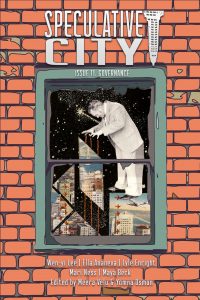John Langan The Ones Who Are Waving by Glen Hirshberg
 The Ones Who Are Waving, Glen Hirshberg (Cemetery Dance 9781587676314, $40.00, 208pp, hc) March 2018.
The Ones Who Are Waving, Glen Hirshberg (Cemetery Dance 9781587676314, $40.00, 208pp, hc) March 2018.
“Freedom is Space for the Spirit”, the first story in Glen Hirshberg’s excellent collection, The Ones Who Are Waving, is a tale of returns. It begins when Thomas, its protagonist, receives a telegram from Vasily, a friend from his youth, requesting his return to St. Petersburg. As a university student, Thomas left then-East Germany for a year abroad in the then-Soviet Union, which was in the grip of Gorbachev’s Perestroika. After ditching his minders, he joined with Vasily and a group of like-minded students in making guerrilla art, until the group was arrested by the St. Petersburg police and Thomas was returned to Germany, in time, as it turned out, to help with the dismantling of the Berlin Wall. Now a tenure-track-professor whose wife is expecting their first child, Thomas has traveled a considerable distance from his student days. Nonetheless, at his wife’s urging, he heeds Vasily’s summons, voyaging by train from his Charlottenberg apartment to the Russia of Vladimir Putin.
Pretty much the moment he arrives in St. Petersburg, Thomas has his first, startling encounter with one of a number of bears roaming the city. The animal is sitting in the middle of a parking space, and what is perhaps more surprising than its presence there is the way the men and women who see it react to it: either they snap pictures of the bear with their phones, or they ignore it altogether. Needless to say, Thomas is confused, as he is during subsequent sightings of other bears within the city, all of them treated as at best curiosities, at worst one more feature of the urban landscape. Eventually, he learns the reason the animals are dismissed: they have no mouths and are thus slowly starving to death. The bears’ unexpected presence gives the story something of the feel of a narrative by one of the great Russian fabulists, Gogol or Bulgakov. It’s impossible not to see the bears and their mouthless condition as reflective in some way of the current state of Russia, an implication of which Thomas is aware. Are these animals, he wonders, symbolic of a country grown gentler, or do they represent an old dream of empire which has lost its potency? Despite a close encounter with one of the animals on a bus which reaffirms the bears’ materiality, Thomas finds it difficult not to view them as a kind of living art project. Yet the building that was once the center of his and Vasily’s artistic endeavors stands silent and empty, reduced to an official museum. As for Vasily, he is nowhere to be found.
Thomas’s effort to find his friend leads him to the office of a local paper that published a story about the bears, but the paper’s editor is suspicious of him, reluctant to discuss anything about the reporter he says he has sent out of town for her safety. Meet the new Russia, same as the old Russia. Frustrated, Thomas departs the paper’s office, only to stumble into a chance encounter with Vasily’s niece, Ana, a child the last time Thomas saw her, now an adult. Through Ana, he begins to learn of his old friend’s more recent activities, which have included an extended stay in the far east of the country. When at last Thomas and Ana locate Vasily, he fills in the rest of the details of his trip. While in Siberia, Vasily spent time with local shamans, slowly gaining their trust in order to be taught their art, specifically, a ritual called the Bear Ceremony. Vasily’s goal was to use the ceremony to effect his own renewal of the country by bringing it into literal contact with forces from its aboriginal past, a kind of late-Modernist project. The condition of the bears Thomas has encountered shows how well Vasily succeeded, nor is that the worst in store for the animals. What began almost whimsically ends in tragedy. The story concludes on a note of qualified hope, suggesting that dreams of a better future might focus on what lies ahead, rather than seeking to resurrect an idealized past. Although Hirshberg has not often been read as an explicitly political writer, a number of his stories, including “Dancing Men” and “America Morons”, engage matters of history, memory, and cultural identity. “Freedom is Space for the Spirit” does the same with gusto, creating a heartbreaking parable of the search for a glorious, mythic origin and the costs it exacts from those engaged in it. It is as timely a story as any Hirshberg has written.
In many ways, “Freedom is Space for the Spirit” lays out the major themes that run through the stories that follow it. There’s a concern with the passage of time, particularly personal time, which reaches its apex in the astonishing title story. “The Ones Who Are Waving: A Ballad of the Rolling Darkness Review” starts as a memoir of Hirshberg’s co-creation of and continuing participation in the Rolling Darkness Review, a theatrically inflected approach to ghost story telling, and develops into something far stranger, a dramatization of finding oneself caught within the mechanisms of processes vast and mysterious. It’s both a commentary on realizing one’s identity as a writer within a particular generic tradition, and a more general reflection on the process of aging, of seeing oneself at a specific moment in the unfolding narrative of one’s life. Both of these are realized through the conceit of being haunted by one’s own self, especially as that self is enacted publicly. The story manages to be both poignant and chilling, no mean feat for so meta-fictive a tale.
The stories in the collection also display a recurring interest in varieties of art, with an emphasis on its dramatic strains, as well as in the idea of the return. All three of these themes, the passage of time, the performative, and the return, are realized brilliantly in “A Small Part in the Pantomime”, Hirshberg’s sequel to his 2000 story, “Mr. Dark’s Carnival”. It’s a risky move, venturing back to the setting and material of the earlier story, Hirshberg’s first published tale and something of a modern classic, but this is exactly the gamble he takes, returning to Eastern Montana University-Great Plains to pick up and extend the story of previous tale’s protagonist. He does so within the frame of a ghost story, told by David Roemer’s former colleagues in the Literature and Composition department, to Jalena Russell, their newly tenured colleague. As with the earlier story, the time is Halloween in a town famed for its seasonal displays, although the decorations are not what they used to be, diminished by encroaching Christian fundamentalism, while the university is diminished from what it once was, on the verge of abolishing the tenure system Jalena has just threaded her way through. Together, Jalena and her fellow professors pile into a pickup truck and drive around and then outside the town, the older faculty taking turns relaying what they know of the events of the story we know as “Mr. Dark’s Carnival”, and then relating what became of their friend afterward as, haunted by grief and loss, he sought to find his way back to that most sinister of carnivals. While the narrative progresses, Jalena is aware of undercurrents of emotion flowing among her colleagues, of their desires and frustrations, their failings and resentments. If the pickup seems like a mobile Greek chorus, it’s a chorus whose members feel quite free to interrupt one another, to correct one another, to snipe at one another. Even as the professors are narrating Roemer’s increasingly desperate efforts to locate the carnival at which he lost so much, another story emerges alongside it, that of the lingering pain and jealousy among three of the pickup’s passengers, who once formed the sides of a romantic triangle. Rather than simply repeating the principal story, this one refracts it, exploring desire and grief from another angle. And while both tales are unfolding, the truck is moving through the town’s Halloween landscape, its displays and decorations the visible representations of the invisible forces at play. Eventually, the professors drive out into the surrounding countryside, where David Roemer’s quest reached its tragic climax, and where his colleagues’ comes to its own terrible conclusion. If Hirshberg takes a big chance here, then his reward is a tremendous pay-off, a story that expands the original while standing as its own piece of art. It’s a bravura performance, the kind of literary high-wire act that makes you want to stand up and applaud.
The same might be said of the collection as a whole. Its stories exemplify Glen Hirshberg’s ambition and ability. Here is the carnival, in all its awful, shadowed splendor: get your ticket quickly.
John Langan is the author of two novels, The Fisherman (2016) and House of Windows (Night Shade 2009), and two collections of stories, The Wide Carnivorous Sky and Other Monstrous Geographies (2013) and Mr. Gaunt and Other Uneasy Encounters (2008). With Paul Tremblay, he co-edited Creatures: Thirty Years of Monsters (2011). One of the founders of the Shirley Jackson Awards, he served as a juror for its first three years. He lives in New York’s Mid-Hudson Valley with his wife and younger son.
This review and more like it in the September 2018 issue of Locus.
 While you are here, please take a moment to support Locus with a one-time or recurring donation. We rely on reader donations to keep the magazine and site going, and would like to keep the site paywall free, but WE NEED YOUR FINANCIAL SUPPORT to continue quality coverage of the science fiction and fantasy field.
While you are here, please take a moment to support Locus with a one-time or recurring donation. We rely on reader donations to keep the magazine and site going, and would like to keep the site paywall free, but WE NEED YOUR FINANCIAL SUPPORT to continue quality coverage of the science fiction and fantasy field.








This one sounds really good. I really like a well written science fiction. Right now reading Neuromorphs by Dennis Meredith. It’s a real hard sci fi, a lot of technology in it with the military aspect in the SEAL team. Not to mention a race of robots that are essentially built to live just like humans. Pretty good hook there! dennismeredith.com for his info. I think this is a good recommendation.